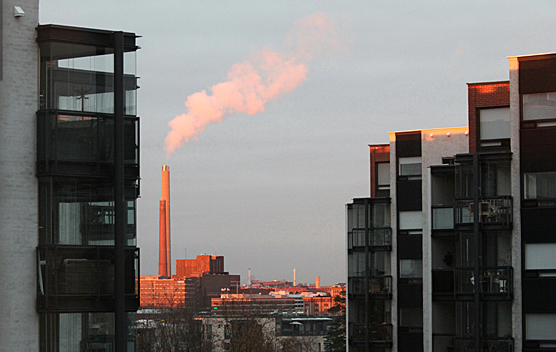
© Olli-Pekka Pietiläinen
The Finnish Environment Institute (SYKE) has launched a novel calculation system bringing together all the greenhouse gas emissions from different cities, municipalities and regions around the country in one platform. The calculations website is a unique visualization of each Finnish municipality’s emissions status from 2005 onwards.
“The emissions calculation is a central tool in climate policy, and as far as we know, it’s the first in the world of its kind. It is vitally important, that we have a trustworthy, transparent and a commonly accepted model tracking emission trends. We know where emissions are created and how to cut them, but in order to make credible policies, we need clear indicators”, says Johannes Lounasheimo, a senior specialist leading the emissions assessment project in SYKE.
Finland shows promising results overall, but regional differences are significant
Cities, municipalities and regions have taken an active role in fighting climate change and set ambitious goals in order to decrease greenhouse gas emissions. With the help of the calculations, cities can see where their emissions originate from, whether their climate actions have had an impact and check if their neighbouring area is cutting emissions in a more efficient way.
Results from the emissions calculations are promising but not yet sufficient: emissions have decreased an average of 15 per cent in Finnish municipalities from 2005 to 2017, which is the latest year of calculated results. Nearly all regions have seen a cut in greenhouse gas emissions from 2005. The biggest decreases have been reached in the electricity sector, in district heating production and in certain areas due to the construction of wind power. Also, the emissions from oil heating have decreased fairly steadily in all municipalities, which has had a big impact on the national level.
In 2017 agriculture was responsible for 17 per cent of the municipalities’ total emissions, but the proportion varies greatly depending on the region. “In the agricultural sector we have not seen – and we are not expecting – a decrease similar to for example district heating, where it is rather straightforward to replace fossil fuels with cleaner alternatives”, Lounasheimo says. “However, each sector has to have its own fair share of the emission cuts”, he adds.
Some municipalities are already close to being carbon neutral, whereas in a few areas the emissions have increased from the year 2005. Lounasheimo warns of drawing straightforward comparisons between different municipalities according to the calculation results. Finland is a geographically large country where municipalities are very different. “We need to be very careful when interpreting these results, and when ranking municipalities based on their emissions. Municipalities have different starting points, economic structures and demographic factors”, says Lounasheimo.
Closer cooperation and bolder action are still needed
The shared calculations platform brings Finland one step closer to the country’s ambitious goal of carbon neutrality by 2035. “In general, every single municipality needs to be carbon neutral by 2035. The state can steer the development with legislation, but most of the work in practice is done in the municipalities, and that work is extremely important”, says Lounasheimo.
“We need a shared vision, inside the municipalities’ administrations but also between different actors. We need businesses, citizens, land owners and everyone else to get involved. We need to have a common understanding about where we want to be in 10 years, and how we are going to get there. The changes that need to be made are tremendous and continuing in the current path is no longer an option”, Lounasheimo insists.
The user-friendly greenhouse gas emissions service is available for all in Finnish and in English. Visitors can click on their municipality or province and see the emissions development in 2005–2017 as well as the distribution between different sources. The service also allows for changing the calculation methods for in-depth analyses. The emissions table can easily be copied for further use. The results for 2018 will be published in June 2020.
Read more
Further information
- Johannes Lounasheimo, Senior Specialist, Finnish Environment Institute, firstname.lastname@ymparisto.fi